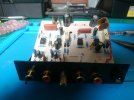I have a Project "The Phono Box" preamp which I have been using for 20+ years.
I'm capable of soldering, and have a little understanding of electronics. What parts should I be looking to refresh?
It has been making a muffled crackle when switched on from cold, for many years. Because of this, I've just replaced the two 25V 470uF capacitor and I'll see what happens. I assumed (perhaps incorrectly!) these are smoothing of the DC power input.
But now it's drawn my attention to other things. The sound has always been 'soft' to my tastes, but I do seem to EQ to a very bright and detailed sound. Also I think a little distortion may have appeared over the years as I'm noticing the 'warm' fuzz around vocals more and more that I don't hear on CDs.
However, these are just subjective judgements, I could be noticing what I didn't before.
So what is the actual science here? ie. which of the parts of the preamp have the most profound impact on the sound, and which will wear or age?
My understanding is the RIAA curve is defined by a specific set of capacitors; if so, the accuracy of the equalisation from new should never really be in question. But if these capacitors could age, could this cause distortion, or softness? Are these the electrolytic capacitors I can see (what about the others?) and should I replace all of them?
And the op-amps. Do these suffer any kind of 'ageing' or is it just a matter of the quality/cost of them? The small chips I can see are MAL TL061CN 90A806 and 458D JRC 11776.
I'm not an electronics person, but this is a good opportunity to learn a little -- many thanks.
I'm capable of soldering, and have a little understanding of electronics. What parts should I be looking to refresh?
It has been making a muffled crackle when switched on from cold, for many years. Because of this, I've just replaced the two 25V 470uF capacitor and I'll see what happens. I assumed (perhaps incorrectly!) these are smoothing of the DC power input.
But now it's drawn my attention to other things. The sound has always been 'soft' to my tastes, but I do seem to EQ to a very bright and detailed sound. Also I think a little distortion may have appeared over the years as I'm noticing the 'warm' fuzz around vocals more and more that I don't hear on CDs.
However, these are just subjective judgements, I could be noticing what I didn't before.
So what is the actual science here? ie. which of the parts of the preamp have the most profound impact on the sound, and which will wear or age?
My understanding is the RIAA curve is defined by a specific set of capacitors; if so, the accuracy of the equalisation from new should never really be in question. But if these capacitors could age, could this cause distortion, or softness? Are these the electrolytic capacitors I can see (what about the others?) and should I replace all of them?
And the op-amps. Do these suffer any kind of 'ageing' or is it just a matter of the quality/cost of them? The small chips I can see are MAL TL061CN 90A806 and 458D JRC 11776.
I'm not an electronics person, but this is a good opportunity to learn a little -- many thanks.

